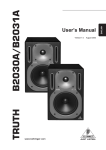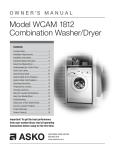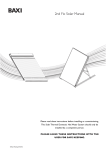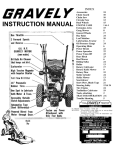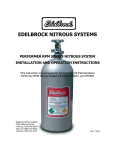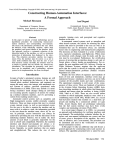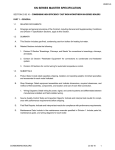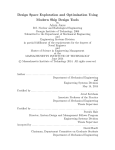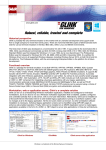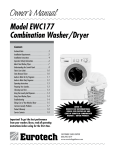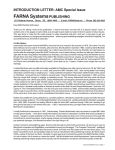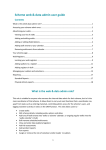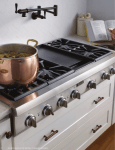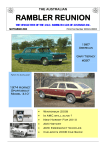Download HMM_Rambler_American_1959_Super_
Transcript
AUTO CLASSIFIEDS | CLASSIC CARS FOR SALE | CLASSIFIEDS Home Classifieds My Hemmings Publications Research Store Directory Forums Downloads About Us Members: Log in | New User? Register Search All Classifieds FEATURE ARTICLE from Hemmings Classic Car Home > Contents RAMBLING AMERICAN Hemmings Classic Car - MARCH 1, 2006 - BY STEVE MAGNATE Print This Article Preparing a 1959 Rambler American Super Two-Door Club Sedan to be a daily driver I'll admit it right now--when I was a child, these things gave me the creeps. I was born in 1964 and was fully car conscious by the age of six. In 1970, rust hadn't yet claimed the many 1950-'55 Nash Ramblers and 1958-'60 Rambler Americans still rolling the streets of my Massachusetts hometown. The thing that really disturbed me about these little cars was the uniquely grotesque mismatch between the 73-inch-wide body and 55-inch track. This curious feature made the car look like it was about to tip over or had suffered a freak broadside curb shot. To my eye, it was a turtle sitting on a roller skate and a stark contrast with the sleek Cougars, Tempests, Galaxies and Challengers on the roadways of the day. Three decades have passed since and, now with a slightly higher level of maturity, I often find myself oddly attracted to those things that once repulsed me. And so it is with my 1959 Rambler American Super two-door Club Sedan. Now I understand that the narrow track was originally mandated by Nash's Airflyte styling motif which sought to hide the wheels as items too mundane for the blinding optimism of post-war transportation. It was the dawn of the Jet Age; weren't all cars supposed to be floating on air? Visible wheels only betrayed the vulgar reality that actual contact with the earth's surface was still required for trips to the grocery store. In achieving the Airflyte effect, Nash exterior stylists and chassis engineers undoubtedly arm-wrestled over how much skirting was practical before the wheels were entombed by the body, making changing a flat tire--or steering--impossible. The stylists won, and between 1949-'54 the upper halves of all models' wheels, from the tiny Metropolitan to the plush Ambassador, were seamlessly hidden. Thus was born the stereotypical bathtub Nash. The side effect that troubled me as a kid was the seemingly narrow track, which really wasn't much different from the industry standard, but rather an illusion fostered by the bulbous bodywork. When Nash president George Mason passed away suddenly in 1954, the biggest champion of enclosed wheels was gone. For the 1955 model year and beyond, chief stylist Edmund E. Anderson, who disliked the look, began liberating wheels model by model, the sole exception being the micro-sized Metropolitan, which remained skirted until its demise in 1961. In the case of the compact Rambler, the front fenders grew attractive full-size wheel cutouts that stayed put until the Rambler's temporary discontinuation during the 1956 and 1957 model years. When it returned as the lightly facelifted American Motors Rambler American for 1958, the rear wheel cutouts were also given a full opening--albeit with a sharply contrasting teardrop shape. The rub to all of this is that, despite the eventual unveiling of the wheels at all four corners, the 55-inch track measurement was stuck in the obsolete Airflyte mode, giving the American that ungainly teetering turtle look that frightened me as a kid. Clearly the chassis engineers vetoed the idea of bringing the wheels outward, an expensive move for sheer aesthetics. All of which brings us to the present time and my recent discovery of this 1959 Rambler American Super at a local repair shop. Its owner had just pulled it out of eighteen years of storage in a Hollywood garage and hired the shop to get it going. But a persistent engine miss signaled deep trouble, and the shop was authorized to sell. So for the sum of $2,750, the sputtering Rambler was mine. Sure, a coat of dead silver paint covered the original Frost White exterior, the front bumper guards were missing and the automatic transmission slipped and shuddered, but the interior was in excellent condition, there was no rust and the optional Continental spare tire just sorta got me right there. Having every intention of using the Rambler as my sole means of daily transportation for the foreseeable future, I decided to embark on a selective refurbishment process to ensure reliability. The first area of business was the sputtering engine. Tracing its roots very directly to the 172.6-cu.in. straight-six first used in the 1941 Nash 600, the American's 195.6-cubicinch Flying Scot L-head is a marvel of simplified design. The cylinder head doubles as the intake manifold and the exhaust manifold consists of a fabricated steel tube clamped to the side of the block. Though rated at a seemingly meager 90hp at 3,800 rpm and 150-lbs.ft. of torque at 1,600 rpm, this pre-war design was praised by the motoring press for its peppy performance. In the May 1958 issue, Motor Life said: "Acceleration is considerably better than for such cars as the VW, Renault Dauphine or Vauxhall Victor. In fact, the American will outdig any of the under$2,500 imported sedans except the Volvo 85hp models, which are slightly quicker." You could have fooled me. A rough idle and general inability to exceed 60 mph signaled the need for some investigation. A cranking compression test revealed that cylinders 1,2,3,5 and 6 all measured between 95and 120-p.s.i., not the ideal--you'd like to see less than a 10-percent variation--but certainly not terrible. But the reading from cylinder 4 was a depressing 45-p.s.i., indicating either bad rings or valves and an inevitable reduction in the thickness of my wallet. My dreams of getting it running for under $3,000 were dashed. The engine had to come out. I soon discovered that the Rambler's engine bay is too short for the vertical passage of the combined length of the engine and transmission. The Kenosha assembly plant built these cars by lowering the suspended body shell onto the powertrain. Lacking these resources, the solution was to separate the engine and transmission in the car and lift the ailing engine straight up with a hoist. Then the automatic transmission was lowered from the bottom. It was here that one of the American's many design quirks surfaced. The driveshaft is trapped between the transmission and rear axle. Separation involves unbolting the forward leaf spring hangars, shock absorbers, brake hose retainer and hand brake cable from the chassis and lowering the entire rear axle assembly to "unplug" the driveshaft! There is no other way. With the engine and transmission out of the car, the autopsy began. Though the bearings, journals, camshaft and tappets displayed the kind of moderate wear you can talk yourself into ignoring, the number 4 exhaust valve was burned. I turned a mental corner and accepted the fact that the engine needed a complete rebuild. The block was bored .030-over, decked .010 and had new cam bearings installed, the valve seats were ground, the crankshaft journals turned .010, connecting rods cleaned and the slab-like cylinder head was milled .020 to increase the compression ratio from 8:1 to about 8.3:1 for a little more power. The machine shop bill came to $679. Internal engine components were sourced from Egge Machine in nearby Sante Fe Springs, California. The shopping trip netted pistons ($230), rings ($54), main bearings ($103), rod bearings ($65), cam bearings ($80), tappets ($160), intake valves ($58), exhaust valves ($97), valve springs ($56), rebuilt oil pump ($43), new fuel pump ($60), timing set ($72), and a gasket set ($49). The stock camshaft was sent out for a re-grind ($63) to extend its life and add a little breathing capability. The beautiful thing is that the expense of refurbished pushrods and rocker arms is conspicuously absent from the total engine rebuild tally on this flathead. All told, the engine refurbishment cost $1,190 for parts plus the $679 machine shop fee, for a grand total of $1,869, not including tax. Further savings were realized by assembling the amazingly simple engine myself using the factory service manual as a guide. Like the engine, the ailing automatic transmission was removed and rebuilt. While the threespeed manual transmission/overdrive combination installed in most Ramblers garnered a reputation for incredible fuel economy, automatic transmissions were also available to Nash Rambler customers beginning in 1953. Initially, the four-speed GM-sourced Hydra-Matic was offered. It had forward ratios of 3.82, 2.63, 1.45, 1.00 and a super-steep 4.30 reverse. Essentially the same transmission used in Cadillacs and even certain Lincolns, the HydraMatic was an awful lot of transmission for such an economy-minded car but remained optional until the Rambler was discontinued at the end of the 1955 model run. When the 1958 AMC Rambler American rose from the grave, the Hydra-Matic was gone. In its place was the new three-speed Borg-Warner M8. Dubbed Flash-O-Matic and selling for $178, the M8 had forward ratios of 2.40, 1.47 and 1.00 with a 2.0 reverse gear and a cast-iron case. Though Borg-Warner also supplied similar automatic transmissions for more expensive Detroit offerings from Ford, Packard, Studebaker and others, those destined for economy car applications were air-cooled to reduce cost. External cooling line bosses are present on the iron case, but they are not tapped for the customary radiator tank cooling lines. The castaluminum transmission adapter features screened openings that allow air circulation to the special finned torque converter. Not having previous experience with the M8, I limited my involvement to a complete disassembly and thorough cleaning of all parts before delivering them to a local transmission shop. Frankly, the multi-piece valve body had me confused and I lost track of what springs and balls went where, so I chickened out and, for $410, the Flash-O-Matic was rebuilt for me. Initially the transmission shop feared rebuild parts would be impossible to find but soon realized that common Ford-O-Matic and FMX rebuild parts are transferable. Unlike senior Nash and AMC models which incorporate torque-tube rear axle designs, the Rambler and American fed power to the rear axle via an open driveshaft. Despite sitting dormant for 18 years, the rear axle required only a fluid change and a new inspection cover gasket. Though 3.78 gears were installed in manual transmission applications and overdrive buyers got 4.10s, I resisted the temptation to trade freeway economy for extra acceleration, and stuck with the standard 3.31:1 ratio. An optional Twin-Grip clutch type limited-slip differential was optional for $29.50, sexy to be sure, but completely unnecessary in sunny Southern California. Fortunately for my dwindling finances, the Gemmer-sourced manual steering box and tie rod ends were in excellent condition and required only rejuvenating lubrication. Same for the suspension, the stone axe reliability of the rear leaf springs speaks for itself. The shock absorbers were even O.K. At the front, I got lucky and found the steering knuckles, trunnions and bushings to be road-ready. Good news because worn trunnions can be expensive to replace. The Rambler's unconventional front suspension uses coil springs that fit between the upper A-arms and fender wells. The weight of the car is carried in part by a cage containing ball bearings. When you turn the steering wheel, the spindles swivel on these cages. There are no ball joints in this ancient but sturdy design. The brakes were another story. Though 1958 saw an increase in drum size to 9 x 2 inches front and rear and 139.4 square inches of effective brake surface--versus the 104.3 square inches afforded by the 9-inch front, 8-inch rear drums used on 1950-'55 models--the twodecade hibernation had transformed the brake fluid inside the wheel cylinders into a damp sand-like substance. I used a hone to recondition the wheel cylinders and found the rubber hoses and steel lines to be worthy of reuse after a thorough flushing. The worn brakes were easily and inexpensively replaced with relined Raybestos (PN 158PG) shoes from the local parts store for $21.99 a pair. The same part number is listed for AMC Hornets, Gremlins and Javelins well into the 1970s. Brake drums are also common to many newer AMC cars and retail for around $70 each. Fortunately, mine were still serviceable. One brake system annoyance is the location of the master cylinder beneath the driver's floorboard. A small access plate must be removed to fill the reservoir and bleed the brakes. Not only does this force the mechanic to lie prone beneath the steering wheel in cramped quarters, but extra care must be taken to avoid spilling brake fluid inside the car. Along with the 1958 increase in braking power, AMC upgraded the previous 1950-'55 four-lug hubs, drums and wheels to the same 5- on 4-1/2-inch bolt pattern used on nearly every subsequent non-Jeep RWD AMC passenger car right up to the bitter end. One unexpected detail is the presence of factory-issued left-hand lug nuts on the driver side. I splurged and fitted the stock 15 x 4 stamped-steel rims to $417 worth of 6.00-15 Denman bias-ply tires from Lucas Automotive. I admit that modern radial tires would likely offer better handling and fuel economy due to reduced sidewall deflection, but I can't accept their toomodern looks on older cars. I much prefer the square-shoulder look and attractive tread pattern of bias tires and especially take issue with those who say bias-ply "collector" tires are dangerous. It's not the tires that are dangerous, it's driving an older car hard enough to notice a difference between radial and bias-ply tires that is dangerous. Like all Nash-built cars since 1949, the Rambler features unit construction. While it is indeed light, I am surprised by how flimsy certain areas are. Sure, the basic body shell is plenty rigid and the doors close with a reassuring thunk, but if you grab the front fender lip and pull gently, the entire corner of the car flexes as if to warn you of its worthlessness in a collision. Same goes for the hood, which has virtually no bracing and feels like you could tear it off its hinges if you got mad enough. By odd contrast, the trunk lid is much better braced and feels far more substantial. The shockingly flimsy construction extends to the front frame and cross members, where on most cars, a floor jack can be used for lifting during service. Try it on either of the two stampings beneath the engine and you'll watch in horror as they start to bend long before the tires come off the ground. In fact, the only way to jack the front end is by the bumper jack (one corner at a time) or by placing a thick steel beam between the frame rail extensions behind the bumper and jacking from there. The front engine mounts are another amazingly dainty item. Constructed of sandwiched rubber, they form a connection of sorts between the timing chain cover and engine mount crossmember. Notorious for failing, the spinning harmonic balancer becomes the engine mount, when they do. On this car, the contact was so severe that the balancer hub was fractured and I had to pay $100 for a used replacement. New engine and transmission mounts are available from Egge Machine ($58 for all four) to replace failed originals. In 1959, the American was available in Deluxe and Super trim levels. Besides a tiny bit of external brightwork and specific badges, the biggest difference is found inside. The Super has four padded arm rests, a right-hand sun visor, cigarette lighter, foam-cushion front seat, map and glove-box lamp, automatic dome lamp and roll-down rear side windows. Both trim levels had a standard front bench seat that folds forward to allow rear passenger entry, but you had to pay extra to get the Airliner reclining front seat like the one in this car. Still, in this 100-inch-wheelbase application, full horizontal seat back positioning is foiled by the intrusion of the rear wheel houses and reclining is limited to 45-degrees. Only 1954-'55 Ramblers built on the optional 108-inch wheelbase were capable of transforming into rolling motel rooms. Wet weather brings out a host of moisture-related interior problems, some rooted in the original design of the car, others caused by age. Due to the extreme tumblehome of the A, B and C pillars, every time you open the doors, accumulated water drips from the door frame onto the seat or your shoulder; a lousy way to start a journey. If you open the wind wing for ventilation, expect a steady drip of water on your knee unless you keep your legs uncomfortably close together. And from the planned obsolescence department, there are no drain holes in the bottoms of the doors. Once the rubber weather strip shrinks, up to two inches of water can accumulate inside the doors with no place to go. You'll hear it sloshing for days after the sun comes out until you finally drill two simple 3/8-inch drain holes and solve the problem. Driving the Rambler raises serious questions about how much horsepower is really necessary in a daily driver. No, there isn't a wall of torque available for aggressive passing or tiresmoking stoplight getaways, but maybe that's a good thing. The gutsy straight-six encourages a polite, socially responsible driving style and is perfect for those who just want to be at peace with their surroundings and leave the fire breather in the garage for a change. I've got a Hemi Dart and other toys, but constantly worry about traffic violations and jeopardizing my clean driving record in them. Not so in the Rambler. Drive one long enough, and you may well proclaim that the only race you care about is the human race. An interesting detail is how the flathead's absence of pushrods and rocker arms shapes the mechanical symphony by filtering out the timpani section. The product is more bass, a hearty growl at power and an exceptionally smooth, nearly silent idle. Sidle up to any running flathead with a stock exhaust at the next car show, and you'll hear it for yourself. Further evidence of Rambler's emphasis on economy over performance is seen in how the Flash-O-Matic is calibrated. According to the owner's handbook, leaving the gear selector in the D-2 position (1.47:1 gear ratio) blocks access to Low gear (2.40 ratio) when starting out from a stop. With the 3.31 axle this yields an initial 4.86:1 final drive ratio that reduces crankshaft revolutions for maximum fuel economy--that is, if you don't negate the effect with a too-heavy right foot. But if you need to scoot, placing the selector into D-1 gives a 5.71 final drive and a noticeable increase in initial acceleration. I generally leave it in D-2 and get 22 mpg around town and 28 mpg at 60 mph on the freeway. The Rambler is capable of greater freeway speeds--as high as a steady 80 mph without feeling strained--but fuel consumption drops to the 18-mpg range. No doubt with an egg under the gas pedal, it could come close to the 30-plus mpg exploits of the legendary Rambler Mobilgas Economy Run champs. One area where the Rambler really shines is maneuverability. The 100-inch wheelbase allows an amazing 36-foot turning circle that'll have you making random U-turns just so you can chuckle to yourself or impress passengers. Rambler advertising copy rightfully proclaimed, "Rambler fits every garage, every parking space, every budget." The big 17-inch steering wheel gives plenty of leverage to counter the slow 22:1 ratio steering box during three-point turns and while parking. The refurbished brakes are also impressive and slow the car quickly without pulling or fading, although the way the brake pedal sticks up from the floor reminds you the car was designed while Berlin was still smoldering. Inside, the stock tube-type AM radio and mono-tone speaker still work but take 30 seconds to warm up. The Weather Eye heater also works--too well. A stuck water control valve allows a constant flow of hot coolant through the heater core and enough heat--even with the blower fan idle--to warrant rolling down the windows. Until a replacement is installed, the heater has been bypassed with little comfort penalty here in the warm environs of California. It's also a good thing it doesn't rain much in Los Angeles as the vacuum windshield wipers have an alarming habit of stopping dead in their tracks with heavy pedal application when manifold vacuum drops suddenly. This hazard could be solved for driving in wetter climes by switching the vacuum source from the intake tract to the vacuum booster that's built into the fuel pump. Despite these issues, the Rambler American is an excellent daily driver when used as its designers intended. The beautiful thing is that my total investment, including the original purchase price, is $5,647.98. That's pocket change in today's collector-car hobby and a pittance compared to what it takes to buy a new vehicle. Best of all, reviving it helped me beat my childhood fear, and driving it puts me in a good mood. On this count, it truly is a driveable dream. PROS: Inexpensive to buy Rarely seen at car shows Cute enough for mass appeal CONS: Lack of seat belts Flimsy construction, rust-prone Comparatively low resale value Specifications Base price: $1,821 Options on dR car: AM radio, Weather Eye heater, Continental spare tire, Flash-O-Matic transmission, self-adjusting brakes, Airliner reclining seat, dual outside mirrors ENGINE Type: L-head straight-six, aluminum block and cylinder head Displacement: 195.6 cubic inches Bore x Stroke: 3-1/8 x 4-1/4 inches Compression ratio: 8.3:1 (with milled head and block) Horsepower @ rpm: 90 @ 3,800 Torque @ rpm: 150 @ 1,600 Valvetrain: Stock (reground), duration 254 (stock 244), intake lift .345, exhaust lift .345 (stock .340) Main Bearings: 4 Fuel System: Carter YF single-barrel, Carter mechanical fuel pump with vacuum booster Lubrication System: Full pressure, 58-psi oil pump Electrical System: 12 volt, 25-amp Delco-Remy generator Exhaust System: Single, steel tubing exhaust manifold TRANSMISSION Type: Borg-Warner M8 3-speed automatic, air-cooled Ratios: 1st 2.40 2nd: 1.47 3rd: 1:1 Reverse: 2.0 DIFFERENTIAL Type: Hotchkiss, open Final drive ratio: 3.31:1 STEERING Type: Worm and roller type, manual Ratio: 22:1 Turns lock to lock: 3.5 Turn circle: 36 feet BRAKES Type: Lockheed hydraulic, manual Front: Bendix Duo-Servo, 9x2-inch cast-iron drums Rear: Bendix Duo-Servo, 9x2-inch cast-iron drums Total swept area: 139.4 square inches CHASSIS & BODY Construction: All-steel welded unit construction Body style: Two-door sedan Layout: Front engine, rear-wheel drive SUSPENSION Front: Independent, parallel arms, direct acting coil springs, tubular shocks Rear: Live axle with semi-elliptic leaf springs, tubular shocks WHEELS & TIRES Wheels: Pressed steel Front/rear: 15 x 4-inches Tires: Denman tubeless Elegante Premium Sports, 4-ply Front/rear: 6.00-15 WEIGHTS & MEASURES Wheelbase: 100 inches Overall length: 185.5 inches (178.3 w/o Continental tire carrier) Overall width: 73 inches Overall height: 57.3 inches Front track: 54.6 inches Rear track: 55 inches Curb weight: 2,435 pounds CAPACITIES Crankcase: 4 quarts Cooling system: 12 quarts w/Weather Eye heater Fuel tank: 20 gallons Transmission: 10 quarts, type A CALCULATED DATA Bhp per c.i.d.: 0.46 Weight per bhp: 27.06 pounds Weight per c.i.d.: 12.4 pounds PERFORMANCE 0 to 30 mph: 4.3 seconds 0 to 60 mph: 19.9 seconds Top speed: 90 mph (Data courtesy of Motor Life, Jan. 1959) PRODUCTION Deluxe Sedan: 29,954 Deluxe Business Sedan: 443 Deluxe Station Wagon: 15,256 Super Sedan: 28,449 Super Station Wagon: 17,383 This article originally appeared in the MARCH 1, 2006 issue of Hemmings Classic Car. Order Backissues of Hemmings Classic Car Here. 1281834 ONLINE: Home | Classifieds | Parts Locator | Clubs | Online Tour | About Us | FAQs | Terms & Conditions | Privacy Policy | Contact Us SUBSCRIBE TO PRINT EDITIONS: Hemmings Motor News | Hemmings Classic Car | Hemmings Sports and Exotic Car | Hemmings Muscle Machines Copyright © 1996-2007 Hemmings Motor News











